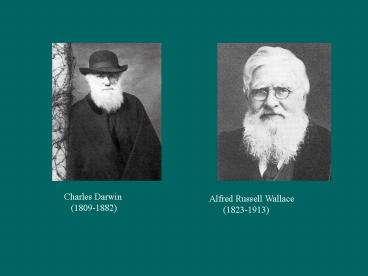Charles Darwin - PowerPoint PPT Presentation
1 / 22
Title:
Charles Darwin
Description:
ship's naturalist on the HMS Beagle (1831-1836) --fossils of Patagonia: similarity of fossil and ... divergence in isolation from a common ancestor --origin of ... – PowerPoint PPT presentation
Number of Views:78
Avg rating:3.0/5.0
Title: Charles Darwin
1
Charles Darwin (1809-1882)
Alfred Russell Wallace (1823-1913)
2
Charles Darwin ships naturalist on the
HMS Beagle (1831-1836) --fossils of Patagonia
similarity of fossil and living forms
(e.g., armadillos). Principle of
succession descent with modification --
fauna of Galapagos Islands each island had
similar physical conditions but distinct
species of mockingbirds, tortoises
(not finches). divergence in isolation from a
common ancestor --origin of coral
atolls required enormous amounts of time
3
1859 Origin of Species
species are not fixed or constant 1.
gradual descent with modification from
a common ancestor (transformation and
diversification) 2. modification via
natural selection on individual variation
Natural Selection differential survival or
reproduction of some individuals under current
environmental conditions
4
(No Transcript)
5
(No Transcript)
6
natural selection in action morphological
evolution of Geospiza fortis
Peter Rosemary Grant and colleagues long-term
study of G. fortis population on Daphne Is. two
episodes of natural selection 1976-77 severe
drought 1983-84 extreme El Nino event
7
(No Transcript)
8
beak depth in G. fortis is highly variable
9
beak depth is highly heritable in this population
h2 0.7-0.8
10
ENSO
drought
11
normal vegetation on Daphne Is.
drought 1976-77
Grant 1986
12
(No Transcript)
13
a decline in food results in a decline in finches
14
(No Transcript)
15
Evolutionary response of Geospiza fortis to
selection in 1976-77
before selection next generation
1976 1978 Mean (SE) Mean (SE)
D
Weight (g) 16.06 (0.06) 17.13
(0.13) 1.07 Wing length (mm) 67.88 (0.10)
68.87 (0.20) 0.99 Tarsus length (mm) 19.08
(0.03) 19.29 (0.07) 0.21 Bill length
(mm) 10.63 (0.03) 10.95 (0.06) 0.32 Bill
depth (mm) 9.21 (0.03) 9.70
(0.06) 0.49 Bill width (mm) 8.58 (0.02)
8.83 (0.05) 0.25 Sample size 634
135
survival is not random larger birds are more
likely to survive than small birds
16
(No Transcript)
17
birds with deeper bills have higher survival
18
(No Transcript)
19
ENSO
drought
20
normal wet season vegetation on Daphne Is.
El Nino event 1983-84
Grant 1986
21
the direction of selection is not constant
22
Natural selection acts on individuals, but the
consequence is a change in the
population phenotypic distribution Natural
selection acts on phenotypes, but changes the
genotypic distribution (without
underlying genetic variation, evolution will not
occur) Each generation is the product of
selection on their parents Natural selection
acts on existing traits. New traits arise as a
modification of old features and in combination
with new mutations Natural selection is
non-random, but not progressive





![[PDF] On the Origin of Species by charles darwin PDF PowerPoint PPT Presentation](https://s3.amazonaws.com/images.powershow.com/10107223.th0.jpg?_=20240824042)














![[PDF] DOWNLOAD Darwin and the Emergence of Evolutionary Theories of Mi PowerPoint PPT Presentation](https://s3.amazonaws.com/images.powershow.com/10088186.th0.jpg?_=20240729071)










